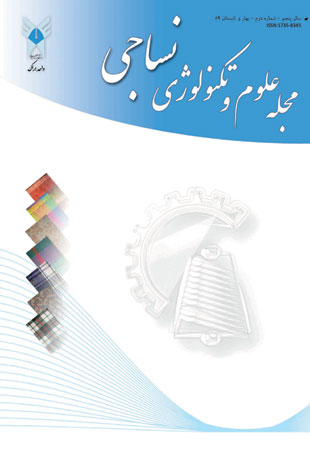فهرست مطالب

مجله علوم و تکنولوژی نساجی
سال پنجم شماره 2 (بهار و تابستان 1389)
- تاریخ انتشار: 1390/09/08
- تعداد عناوین: 10
-
Page 91In this research work, the antibacterial activity of mordant treated cotton fabrics and also dye ability of them after mordant treatment was investigated. Copper chloride, nickel nitrate and silver nitrate were used as mordant. Very good antibacterial activity for mordant treated fabrics were acheived. The Scanning Electron Microscope (SEM) was used for morphological study. The fabric samples were incubated in mordant solution, then were dyed using Acid, Basic and direct dyes as a synthetic dyestuffs and with natural dyes such as madder and Indigo. The effect of mordant procedure on dye ability was investigated. In this research work, type of dye and metal mordant effect were studied. Various colors have been achieved by using different mordants. The results showed that, the effect of mordant treatment temperature on dye ability is not significant but the changes of mordant type causes changes in hue, great deal and purity of colors. Color intensities of the dyed fabrics were measured by using a UV VIS-NIR Reflective Spectrophotometer, over the range of 200-800 nm. The results showed that, by using different mordant before dying, the relative color strength (K/S values) of the dyed fabrics have been increased and it has shown that, more amount of dye can be absorbed. This effect is more significant in case of using basic dyestuffs. Also the shade achieved after mordant treatment is more brilliant as compare to untreated dyed fabrics. The results are discussed in full paper.
-
Page 103The use of cheap, high efficiency and eco-friendly bio sorbent has been studied as an alternative source of activated carbon for the removal of dyes from wastewater. The bio sorption of Methyl Orange (MO) dye from aqueous solution on Camel thorn plant as a local low-cost, available and renewable biological adsorbent was studied. Activated carbon were prepared from camel thorn by chemical activation with 28% H3PO4 followed by pyrolysis at 150°C. Spectrophotometric technique was used for the measurement of concentration of dye before and after adsorption. The effect of various experimental parameters such as contact time, temperature, initial dye concentration and dose of adsorbent were studied. The results showed that the bio sorption of MO as the amount of adsorbent increased, the percentage of dye removal increased accordingly but it decreased with the increase in initial dye concentration and solution temperature. Effect of temperature onto percentage of dye removal shown that the exothermic spontaneity of the bio sorption process. Maximum dye removal was observed at initial dye concentration 20 mgL-1, dose of adsorbent 1.5 g and contact time 120 min at temperature room. Adsorption kinetic data were tested using pseudo-first-order and pseudo-second-order models. Kinetic studies showed that the bio sorption followed pseudo-second-order kinetic model with high degree of correlation coefficients (R2 > 0.99). Langmuir and Freundlich isotherms were used to analyze the equilibrium data at different temperatures ranging (20-40°C) with the intervals of 5°C. The experimental data were more suitable to the Langmuir model than to the Freundlich model. The adsorption capacity maxi mom was calculated as 20.83 mg g-1 at 20°C. The experimental studies were indicated that camel thorn plant had the potential to act as an alternative bio sorbent to remove the MO dye from aqueous solution.

